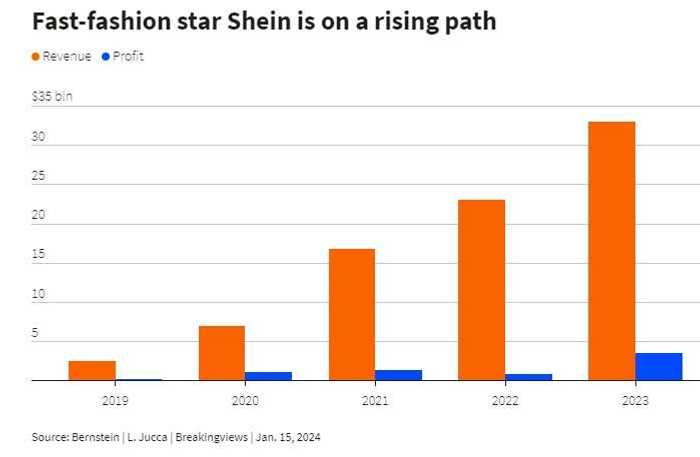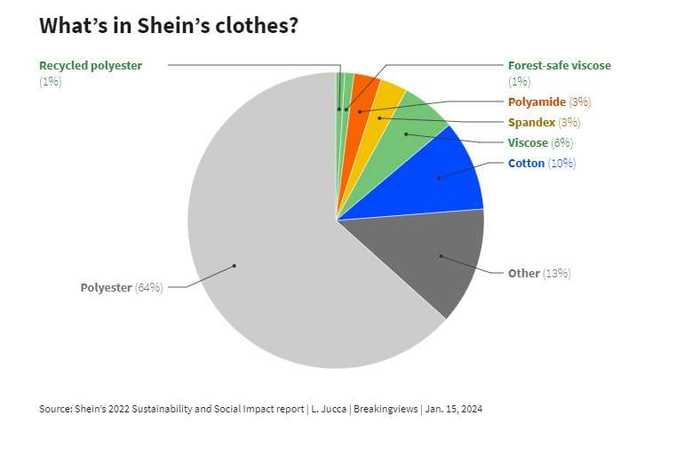Published 15:46 IST, January 19th 2024
Shein’s waste factor is its ultimate IPO risk
Shein Founder Chris Xu’s success formula involves applying an engaging e-commerce style.
Advertisement
Hip or heap? The excitement around Shein’s listing ambitions is overlooking an intractable challenge. The China-linked fashion retailer’s hopes of fetching a $90 billion valuation in a New York initial public offering, per Bloomberg, rest on its ability to continue to sell cheap clothes at a fast pace. Yet its polyester-based garments are carbon-intensive and hard to recycle. Getting on a more sustainable path may require giving up clients or margins.
Within just a few years, Shein has taken retail by storm. Founder Chris Xu’s success formula involved applying an engaging e-commerce style and a just-in-time production logic to the fast-fashion model championed by $130 billion Zara owner Inditex and $24 billion H&M. Shein is likely to have generated a $3 billion profit off nearly $35 billion of revenue in 2023, Bernstein analysts reckon. Plans to boost sales to $60 billion by 2025 imply a staggering 38% annual growth rate from 2022, nearly five times faster than Inditex’s projected 8% yearly growth over the same period, according to Breakingviews calculations. The whole segment is expected to grow 11% annually through 2027 to $185 billion in sales value, market research shows.
Advertisement

Hidden risk
Advertisement
Such rapid expansion may exacerbate a neglected IPO risk: about 85% of the 100 billion tons of textile products that Shein and its competitors churn out each year end up in landfills, as evident from the clothing mountain in Chile’s Atacama Desert that’s now visible from space. On top of that, the industry accounts for between 5% and 10% of global annual greenhouse gas emissions, according to research by the Massachusetts Institute of Technology. Synthetic textile is also responsible for between 200,000 and 500,000 tons of microplastics entering the oceans each year, says the European Environment Agency.
Unease about growing textile pollution is prompting some governments to consider legislation to fight excessive textile production. A bill under consideration in California calls for clothing producers to implement and fund a programme to collect and recycle garments to increase reuse. The European Commission proposed in July that fashion companies either collect a gradually increasing percentage of clothes or pay a fee towards the cost of managing waste.
Advertisement
Shein is already taking steps to make its business more sustainable. Its on-demand model is designed to produce garments only when needed, reducing unsold inventory to a single digit percentage compared with an industry-wide average of about 20% of garments produced each year, according to an estimate by McKinsey. Shein is also looking to increase to 30% its recycled textile content from around 1% in 2022. And it’s allowing consumers to exchange used clothes on its platform to extend these products’ life.

Advertisement
Yet making its business model greener presents a financial challenge. Recycled polyester may be more sustainable, but it’s usually up to a tenth more expensive than regular polyester, according to an industry expert. All else being equal, that’ll eat into the company’s margins, which, at less than 10%, per Bernstein, are much thinner than the roughly 20% enjoyed on average by luxury players, Deloitte reckons.
Meanwhile, if Shein clothes are made to last longer or if consumers do start swapping them more regularly, then it would reduce clients’ need to buy new garments, thus hurting sales. If governments start asking companies to share the cost of managing textile waste, this would also add to expenses.
Advertisement
Aware of the challenge, Shein is hoping to diversify its revenue stream by launching an e-marketplace for other retailers. But it may take time before this business picks up.
For investors, Shein’s neglected waste factor may turn out to be its ultimate IPO risk.
15:46 IST, January 19th 2024
